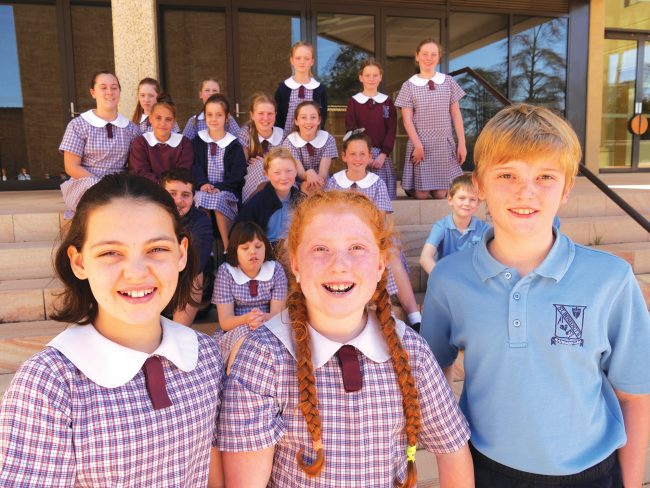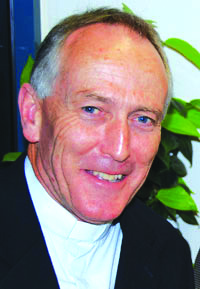One Mission
“It is impossible to persevere in a fervent evangelization unless we are convinced from personal experience that it is not the same thing to have known Jesus as not to have known him . . . “ Evangelii Gaudium, #266

Students at St Benedict’s Primary, Narrabundah.
In 2017 Catholic schools educated 62.2 million students worldwide, many of whom were not Catholic. Since European settlement, the Australian Church has responded to a changing education landscape. In NSW rudimentary education was initially provided by individuals. The introduction of government funding for both public and denominational schools ended for the latter in 1880. As a result, Catholic schools were without government assistance and staffed almost entirely by religious sisters and brothers until ‘State Aid’ was granted some 80 years later, following the symbolic ‘Goulburn Catholic Schools Strike’ of 1962.
Catholic Schools further the mission of the Church, the mission of Jesus. One might speak of the Church’s mission as being to Witness (to teach), to Celebrate (to sanctify) and to Enable (to govern) for the sake of the reign of God. These three related aspects encompass the understanding of Jesus as Prophet, Priest and King with whom the individual is called into relationship as part of the pilgrim People of God.
In essence, Catholic Schools are evangelising communities founded on Jesus Christ, where faith and a way of life in a Catholic ethos are proclaimed and experienced in the pursuit of educational excellence for the fostering of ‘integral human development’. The life of the school points to the story of salvation manifest in the Church’s liturgy, especially the Mass and one’s spirituality arising, not forgetting the governance and pastoral outreach of the Church otherwise (cf. CatholicCare, Marymead and Vinnies) in service of the common good.
In our archdiocese, 25,000 students attend one of the 56 archdiocesan or ‘systemic’ schools supported by the Catholic Education (CE) Office, or one of the three congregational schools (St Edmund’s, Marist and Daramalan). There are eight Early Learning Centres. The budget of $330 million for CE comes from parents and the Federal, NSW and ACT Governments and educates students across an area 30 per cent bigger than Tasmania.
Legislation prevents cross-funding between NSW and ACT schools. The Church has been grateful to government for recent engagement around proposed religious freedom legislation. Collaboration with state and national ecclesial bodies as well as the commitment of the 152 CE office staff ensure that our schools and 1825 full time teachers and support staff are well resourced. The response to the recent bushfires highlighted close collaboration between the office and schools in service of the local community.
The purpose of CE is “to build Catholic learning communities of hope, joy and wonder where all are welcomed and inspired to grow to their potential.” This openness to all is reflected in over 30 per cent of students being other than Catholic.
CE is addressing particular challenges with respect to teacher performance, student achievement and government funding. For many people, education is a product to be purchased (or not) and some Catholics do not maintain the tribal affiliations of their forebears. Government funding is problematic longer term. What should be the future footprint of Catholic education, particularly in the ACT? These and other issues challenge the Archdiocesan Catholic Education Commission in supporting the CE Director Ross Fox and in making recommendations to Archbishop Christopher.
In May Pope Francis will host an international gathering to affirm the value of education. Foundational to it will be the notion of ‘integral human development’, predicated on listening and sharing in the belief that the Church has much to bring to the table. The Church is anything but a ghetto; so too a Catholic school.
The purpose of CE is “to build Catholic learning communities of hope, joy and wonder where all are welcomed and inspired to grow to their potential.” This openness to all is reflected in over 30 per cent of students being other than Catholic. Combined with the majority of Catholic students and their families not regularly identifying with the parish community and there is a rich field for evangelisation.
How might parents as ‘first teachers’ be assisted other than at times of sacramental preparation? A particular challenge is to teach religion and to form people to be religious: to know and to witness in a manner engaging head, heart and hands. The ‘Catholic Schools Youth Ministry Australia’ (CSYMA) has had wide appeal and seeks the same in a parish setting. Again, closer collaboration between School Councils and Parish Pastoral Councils is called for. The negative impact of the Royal Commission into Institutional Child Sexual Abuse and the resultant call for transparency and accountability in Church governance and the cultural emphasis on individuality and relativism have been noted in discussions leading to the Plenary Council.
Nonetheless, the strength of the Church is always in relationships. Only together can our families, parishes and local and regional schools build on a rich legacy so that in Christ we “might have life and have it to the full” (Jn 10:10).

Monsignor John Woods
• Monsignor John Woods is Vicar for Education


